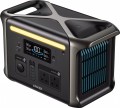Add to comparison |  |  |
|---|---|---|
| ANKER SOLIX C800X | ANKER SOLIX F1500 | |
| Compare prices 1 | Compare prices 4 | |
| TOP sellers | ||
3-mode camping lights. 2 USB A ports, 2 USB C ports. Car cigarette lighter. LiFePo4 battery. Backlight. | 4 USB A ports, 2 USB C ports. Car cigarette lighter. LiFePo4 battery. Backlight. UPS function. | |
| In box | charging station | charging station |
| Rated power | 1200 W | 1800 W |
| Peak power | 1600 W | 2400 W |
| Output waveform | sinusoid (PSW) | sinusoid (PSW) |
| UPS function | ||
Outputs | ||
| Sockets (230 V) | 3 | 2 |
| USB A | 2 5В/2.4А 12 W | 4 5В/2.4А 12 W |
| USB C | 2 3 A, 5 A 100 W | 2 3 A, 5 A 100 W |
| Car cigarette lighter | ||
Inputs (station charging) | ||
| From solar panels | ||
| Input port XT60 | ||
| Add. ports | C13/14 (charging) | |
Battery and charging time | ||
| Battery type | LiFePO4 | LiFePO4 |
| Battery capacity | 768 W*h | 1536 W*h |
| Charging cycles | 3000 | 3000 |
| Charging time (socket) ≈ | 58 min | 120 min |
| Charging time (solar panel) ≈ | 138 min | 216 min |
| Charging time (cigarette lighter) ≈ | 912 min | |
| Charging power (socket) | 1100 W | 1000 W |
| Charging power (solar panel) | 300 W | 600 W |
| Charging power (cigarette lighter) | 120 W | |
General | ||
| Smartphone synchronization | Bluetooth and WiFi | |
| PSU | built into the body | built into the body |
| Display | ||
| Backlight | ||
| Carrying handle | ||
| Operating temperature | 0 °C ~ +40 °C | 0 °C ~ +40 °C |
| Dimensions | 371x205x250 mm | 288x463x237 mm |
| Weight | 10.9 kg | 19.8 kg |
| Warranty | 2 years | |
| Added to E-Catalog | july 2024 | july 2024 |
ANKER SOLIX C800X and ANKER SOLIX F1500 are powerful charging stations but have different characteristics that may influence the user's choice. The SOLIX C800X has a rated power of 1200W and a peak power of 1600W, while the SOLIX F1500 offers a higher rated power of 1800W and a peak power of 2400W, making it more suitable for more demanding devices. Both devices use LiFePO4 batteries with the same number of charge cycles (3000), but the battery capacity of the F1500 is 1536Wh, which is significantly larger than that of the C800X (768Wh). In terms of outputs, the C800X offers 3 sockets at 230V and 5 at 100-120V, whereas the F1500 has 2 sockets at 230V and 6 at 100-120V, which may be important for users with different connection needs. Both devices have UPS functions and support solar charging, but the charging time for the C800X is faster (58 min from the grid compared to 120 min for the F1500). Overall, the choice between these models depends on your power and capacity needs.